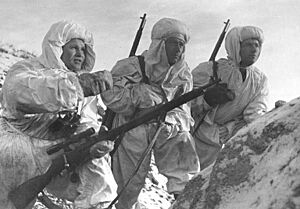Vasily Zaitsev (sniper) facts for kids
Quick facts for kids
Vasily Grigoryevich Zaitsev
|
|
|---|---|

Zaitsev in 1943
|
|
| Native name |
Василий Григорьевич Зайцев
|
| Born | 23 March 1915 Yeleninskoye, Orenburg Governorate, Russian Empire |
| Died | 15 December 1991 (aged 76) Kyiv, Ukrainian SSR, Soviet Union |
| Buried |
Mamayev Kurgan, Volgograd, Russia (from 2006)
|
| Allegiance | |
| Years of service | 1937–1945 |
| Rank | Captain |
| Battles/wars |
|
| Awards | See list |
Vasily Grigoryevich Zaitsev (Russian: Васи́лий Григо́рьевич За́йцев; 23 March 1915 – 15 December 1991) was a famous Soviet sniper during World War II. He was known for his amazing shooting skills.
Between September and October 1942, he took out 40 enemy soldiers. Later, during the important Battle of Stalingrad, from October to December 1942, he eliminated 225 enemy soldiers.
Zaitsev became a hero during the war. He was later given the title of Hero of the Soviet Union. People still admire his skills as a sniper today. His life has been featured in books and movies. The 2001 film Enemy at the Gates tells his story.
Contents
Early Life and Training
Vasily Zaitsev was born in a small village called Yeleninskoye. This was in the Orenburg Governorate of the Russian Empire. He grew up in the Ural Mountains in a farming family.
From a young age, he learned to shoot. He hunted deer and wolves with his grandfather and older brother. When he was 12, he shot his first wolf. He used a special gun given to him by his grandfather.
In 1930, Zaitsev finished college in Magnitogorsk. He studied to become a fitter, which is someone who puts together machines. He also learned about accounting.
Starting in 1937, Zaitsev joined the Pacific Fleet, which was part of the Soviet Navy. He worked in the artillery department. After more training, he became the head of the finance department.
Military Service
When Germany invaded the Soviet Union, Vasily Zaitsev was working in the Navy. He was in Vladivostok at the time. Like many others, he volunteered to go to the front lines. He was a chief petty officer in the Navy. When he moved to the army, he became a senior warrant officer.
He was sent to the 1047th Rifle Regiment. This unit joined the 62nd Army at Stalingrad in September 1942.
Becoming a Sniper
Zaitsev's excellent shooting skills quickly made him a sniper. He was very good at hiding. He would use high ground, piles of rubble, or even water pipes to stay hidden. After making a few shots, he would move to a new spot.
He worked with his partner, Nikolai Kulikov. Together, they made their hiding and shooting tactics even better. One of their methods was called the "sixes." This involved covering a large area from three different spots. Each spot had two men: a sniper and a scout. This tactic is still used by Russian forces today.
Battle of Stalingrad and Injury
Zaitsev fought bravely in the Battle of Stalingrad. In January 1943, he was injured by a mortar attack. This injury affected his eyes. He was treated by a famous eye doctor, Vladimir Filatov. The doctor helped Zaitsev get his eyesight back.
Before his injury, Soviet records show he had taken out 225 enemy soldiers in the Battle of Stalingrad alone.
On 22 February 1943, Zaitsev was honored as a Hero of the Soviet Union. He also helped train many new snipers during his time in Stalingrad. He returned to the front lines and fought until the end of the war. He finished the war as a captain at the Battle of the Seelow Heights in Germany.
Life After the War
After World War II ended, Zaitsev moved to Kyiv. He went to a textile university and became an engineer. He eventually became the director of a textile factory. He worked there until he passed away on 15 December 1991, at the age of 76. This was just 11 days before the Soviet Union broke apart.
He was buried in Kyiv. However, he had always wanted to be buried in the land of Stalingrad, which he had defended so bravely.
Remembering Vasily Zaitsev
On 31 January 2006, Vasily Zaitsev's wish came true. He was reburied with full military honors. His new resting place is at the Stalingrad memorial at Mamayev Kurgan in Volgograd, Russia.
Awards and Honors
Vasily Zaitsev received many awards for his bravery and service:
- Hero of the Soviet Union
- Four Orders of Lenin
- Two Orders of the Red Banner
- Order of the Patriotic War 1st Class
- Medal "For Courage"
- Honorary Citizen of the Hero City of Volgograd (Stalingrad)
- World's Best Sniper of All Time (Moskva)
Images for kids
-
Vasily Zaitsev's sniper rifle, a Mosin–Nagant Model 1891/30 with a PU 3.5x sniper scope. It is on display at the Volgograd's Stalingrad Panorama Museum.
See also
 In Spanish: Vasili Záitsev para niños
In Spanish: Vasili Záitsev para niños




